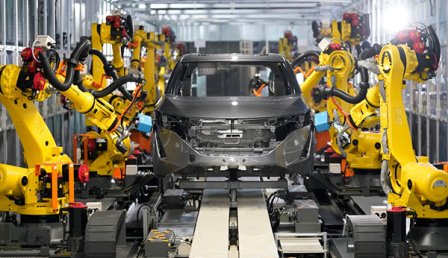While, due to inefficient power supply, Nigerian automakers/assemblers still have to make do with manual production method, many auto makers globally have recorded great efficiency, using automation in vehicle production.
Notwithstanding, IDTechEx research is making case for unleashing robotic workers into auto content warehouses. It’s quite revealing.
The goods-to-person is an order preparation and picking method in which products are delivered directly to the picker by means of automated systems
Traditionally, the goods-to-person method is enabled by large and complex AS/RS systems where shuttle carts, roller conveyors, and stack cranes are used for transporting items. Recently, implementing mobile robots in warehouses for automation has been increasingly popular, and the market of logistic mobile robotics attracts millions or even billions of dollars of investments every year, according to IDTechEx’s report “Mobile Robotics in Logistics, Warehousing and Delivery 2022-2042”.
There are some forms of mobile robotic systems that can complete the “goods-to-person” operations in a more flexible, scalable, and efficient way.
The most widely used mobile robots for “goods-to-person” are grid-based automated guided carts (AGCs) that follow the QR code grid laid on the ground to move shelves or pallets to pickers. The robots work in a compact storage area separated from other working zones. Human pickers only interact with robots through picking stations to pick the ordered items from shelves or pallets.
In addition to grid-based AGCs, a relatively new form of mobile picking robot, case-picking robots started to be deployed by leading mobile robot companies in 2019. Case-picking robots pick and handle regularly-shaped items, such as boxes, bins, totes, and cartons that contain the ordered items to pick, with their telescopic forks or vacuum grippers.
Compared to grid-based AGCs, multi-layer case-picking robots that can carry multiple cartons at one time are more suitable for picking with more SKUs and can be more efficient, space-saving, and less labor-intensive in small or medium-sized warehouses.
On the contrary, grid-based AGCs can be more efficient in large warehouses and can deliver more kinds of items that cannot be placed in cartons. For more detailed analysis and comparison of these two forms of mobile robots, please see the IDTechEx report, “Mobile Robotics in Logistics, Warehousing and Delivery 2022-2042”.
Despite different forms, goods-to-person automation can significantly improve the order picking process in many ways. Four major improvements compared to non-automated picking are listed below:
More efficiency
Picking always makes workers waste most of their time doing non-value-added work of traveling around in the warehouse to find items to pick. As a result, workers alone can only pick maximumly 100-150 items per hour. But with mobile robots, workers only need to stay at the picking station waiting for robots to bring the items, doing the sophisticated picking works that are currently very challenging or impossible for robots to do.
Hence, by using mobile robots to automate the “goods-to-person”, a single picker can potentially pick 600-650 items per hour at maximum.

Less working intensity
If mobile robots are implemented, human workers do not have to walk around in the warehouse carrying heavy items or pulling trolleys. They only need to stay in an area and pick items, which creates a less tiring and less intense working condition.
Less cost
Because of improved productivity and the special “goods-to-person” mode, less labor will be required in the warehouse, and the cost of employment can be considerably reduced. Even though implementing mobile robotic systems requires upfront capital, the ROI should be quick, typically two years. Moreover, recently the Robot-as-a-Service business model has been accepted by more companies and customers, in which customers use the services of providers on a monthly subscription or pay-as-you-go basis.
Lower error rate
The operations of mobile robots are controlled by the fleet management system that is often integrable with warehouse management systems (WMS) and AI-powered. Hence, the system can give robots the optimized routes of transporting items and may change their tasks dynamically with incoming orders. With the least human intervention, the system can precisely bring the desired items to pick, minimizing the error rate in the entire order preparation process.
Apart from picking and “goods-to-person”, mobile robots can be used to improve nearly every operation in the logistic chain. To find out more about technological analysis, current market landscape, and future market outlooks and forecasts of mobile robotics in logistics, please see the IDTechEx report, “Mobile Robotics in Logistics, Warehousing and Delivery 2022-2042”.
©Copyright MOTORING WORLD INTERNATIONAL.All rights reserved. Materials, photographs, illustrations and other digital content on this website, may not be reproduced, published, broadcast, rewritten or redistributed in whole or in part without prior written permission from Motoring World International
Contact: [email protected]




